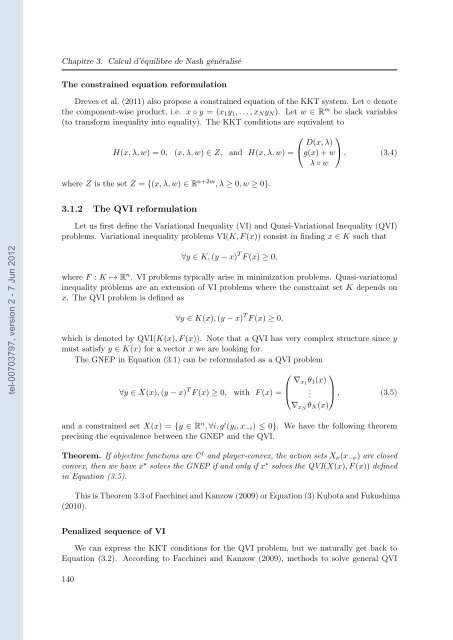Etude des marchés d'assurance non-vie à l'aide d'équilibres de ...
Etude des marchés d'assurance non-vie à l'aide d'équilibres de ...
Etude des marchés d'assurance non-vie à l'aide d'équilibres de ...
Create successful ePaper yourself
Turn your PDF publications into a flip-book with our unique Google optimized e-Paper software.
tel-00703797, version 2 - 7 Jun 2012<br />
Chapitre 3. Calcul d’équilibre <strong>de</strong> Nash généralisé<br />
The constrained equation reformulation<br />
Dreves et al. (2011) also propose a constrained equation of the KKT system. Let ◦ <strong>de</strong>note<br />
the component-wise product, i.e. x ◦ y = (x1y1, . . . , xNyN). Let w ∈ R m be slack variables<br />
(to transform inequality into equality). The KKT conditions are equivalent to<br />
H(x, λ, w) = 0, (x, λ, w) ∈ Z,<br />
⎛ ⎞<br />
D(x, λ)<br />
and H(x, λ, w) = ⎝g(x)<br />
+ w⎠<br />
,<br />
λ ◦ w<br />
(3.4)<br />
where Z is the set Z = {(x, λ, w) ∈ R n+2m , λ ≥ 0, w ≥ 0}.<br />
3.1.2 The QVI reformulation<br />
Let us first <strong>de</strong>fine the Variational Inequality (VI) and Quasi-Variational Inequality (QVI)<br />
problems. Variational inequality problems VI(K, F (x)) consist in finding x ∈ K such that<br />
∀y ∈ K, (y − x) T F (x) ≥ 0,<br />
where F : K ↦→ R n . VI problems typically arise in minimization problems. Quasi-variational<br />
inequality problems are an extension of VI problems where the constraint set K <strong>de</strong>pends on<br />
x. The QVI problem is <strong>de</strong>fined as<br />
∀y ∈ K(x), (y − x) T F (x) ≥ 0,<br />
which is <strong>de</strong>noted by QVI(K(x), F (x)). Note that a QVI has very complex structure since y<br />
must satisfy y ∈ K(x) for a vector x we are looking for.<br />
The GNEP in Equation (3.1) can be reformulated as a QVI problem<br />
∀y ∈ X(x), (y − x) T F (x) ≥ 0,<br />
⎛<br />
∇x1<br />
⎜<br />
with F (x) = ⎝<br />
θ1(x)<br />
.<br />
∇xN θN(x)<br />
⎞<br />
⎟<br />
⎠ , (3.5)<br />
and a constrained set X(x) = {y ∈ R n , ∀i, g i (yi, x−i) ≤ 0}. We have the following theorem<br />
precising the equivalence between the GNEP and the QVI.<br />
Theorem. If objective functions are C 1 and player-convex, the action sets Xν(x−ν) are closed<br />
convex, then we have x ⋆ solves the GNEP if and only if x ⋆ solves the QVI(X(x), F (x)) <strong>de</strong>fined<br />
in Equation (3.5).<br />
This is Theorem 3.3 of Facchinei and Kanzow (2009) or Equation (3) Kubota and Fukushima<br />
(2010).<br />
Penalized sequence of VI<br />
We can express the KKT conditions for the QVI problem, but we naturally get back to<br />
Equation (3.2). According to Facchinei and Kanzow (2009), methods to solve general QVI<br />
140
















